Photography courtesy of Lowell Washburn, all rights reserved.
Letting go can be hard to do – especially when it’s something you love.
McGregor,IA — It was a brilliant spring day, and my wife Carol and I were admiring the view from atop the highest bluff at Clayton County’s Pike’s Peak State Park. Five hundred feet below, the sprawling island studded expanse of the Upper Mississippi River provided one of Iowa’s most scenic backdrops. In addition to being America’s continental drainpipe, the Mighty Mississip’ is also a vital corridor for millions of migrating birds.
But today’s priority went beyond the enjoyment of world class birding or viewing of incredible scenery. Perched on my gloved fist, my trained peregrine falcon, Aurora, calmy waited in the darkness of her hood. The spring migration was surging northward, and others of Aurora’s kind were moving up the Mississippi. After spending the winter in South America, wild peregrines were currently enroute to the cliff ledge nest sites of their arctic breeding grounds. Although Aurora was unaware of the fact, she was about to join that migration. The fact that I had been planning this event for several months was not making its completion any less painful.
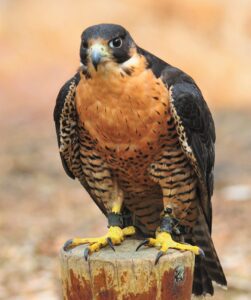
Although I wasn’t aware of it at the time, our saga had actually begun in 1958 when, as a bug-eyed nine-year-old, I watched the original airing of Walt Disney’s “Rusty and the Falcon” – the fictional account of a boy who discovers an injured peregrine, nurses the falcon back to health, and then successfully introduces the bird to the ancient sport of falconry – the practice of using trained raptors to pursue wild game. That single television episode was all it took. I was hopelessly hooked. Of all birds, the peregrine falcon had instantly become my favorite.
From that moment on, I dreamed of what it would be like to pursue wild game in partnership with the planet’s fastest winged hunter. But it appeared as if my dream would remain unfulfilled. By the time I reached High School, peregrine falcons were facing a dark future. A casualty of DDT pesticides, peregrine populations were going down in flames. During a visit to Minnesota’s Bell Museum of Natural History, I was told by staff scientists that the possibility of ever seeing a live peregrine was remote and that the species was likely facing extinction. The preserved study skins displayed in a glass case were as close as I could hope to come.
Fortunately, those dire predictions were wrong. Due to the efforts of an alarmed public, the use of DDT was banned in 1972. Equally significant was the fact that a handful of falconers were attempting to produce offspring from peregrines taken from the wild years earlier. Although there were legions of naysayers, the idea of restoring vanished populations via the release of captive bred youngsters seemed worth an attempt.
During the 1990s, I enjoyed the unfathomable priviledge of spending five consecutive years coordinating and conducting peregrine releases at both urban and rural cliff ledge release sites. The project involved a dedicated coalition of Iowa falconers, professional biologists, and an energized cadre of private sector volunteers. The cooperative effort resulted in the successful release of 102 captive produced, fledgling falcons. Survivors of those releases established successful nesting territories in Iowa, Minnesota, Wisconsin and beyond.
Recovering populations continued to expand nationwide. So much so that, in 1992, the peregrine falcon was removed from the Federal Endangered Species List it helped to create. By 2018, populations had rebounded to the point that Iowa falconers were offered an opportunity to compete for a total of five peregrine capture permits issued through a lottery drawing. Although I applied, demand was high, and I failed in the draw.
Applying again in 2019, I was drawn out for the second year. I also applied in Minnesota and wonder of wonders, was awarded a permit. I couldn’t believe it. I had won the chance to trap a wild peregrine falcon!
The northern shore of Lake Superior is a world-renowned hawk funnel and is Minnesota’s most likely location to net a migrating peregrine. But even here, peregrine trapping can present an uphill challenge, and my first two trips were unsuccessful. Aided by veteran Minnesota falconers Jack Vooge and Ben Ohlander, we were successful in capturing a beautiful first-year female peregrine on my third [October 7th] visit.
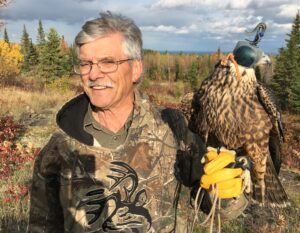
It was an emotional moment. A legal, wild-trapped peregrine falcon was standing on my fist, and she was all mine. A boyhood dream that I’d been harboring for sixty years had become a reality. In recognition of the unknown northern haunts from which she came, I named the bird Aurora.
Although volatile at first, Aurora quickly tamed. Within a month, she had turned from ultimate Dragon Lady to one of the gentlest falcons I’ve handled. Like all peregrines, Aurora loved to fly. When our free flights began, the falcon proved to be exceptionally loyal. And although she frequently drifted beyond my range of vision, she never failed to eventually return.
Historically, peregrines were referred to as the ‘duck hawk’. Aurora soon lived up to that title by developing a natural passion for chasing large flocks of field feeding mallards. But like most young falcons, the 27-ounce raptor was somewhat intimidated by the flailing wings of flocks containing hundreds of loud, 2 ½ pound waterfowl. Consequently, our flights resulted in plenty of terrified ducks but nothing in the gamebag. The scenario was repeated time and again until friend and fellow falconer, Ross Dirks helped engineer a duck flight that was too good to fail. The flight was a success. Lesson learned; Aurora was never intimidated by ducks again, subduing even the heaviest drake mallard with confident ease.

Falconry is one of the oldest known forms of hunting. Originating on the steppes of Mongolia, it’s been around for about 4,000 years, give or take. When first practiced in America, the thrill of training wild peregrines was often combined with a rather unique form of conservation ethic. Adopting a full circle approach, falconers trapped migrating peregrines from the wild, trained those birds to become valuable hunting partners, and at winter’s end returned the raptors back to the wild.
It was a romantic practice to be sure. But modern-day falconers have been deprived of participating in the full circle concept ever since peregrine populations began their pesticide induced demise. That is until now. With limited numbers of wild peregrines once again available to falconers, old traditions can be revived. Poised at the brink of her fourth summer, Aurora and I were about come full circle. She had been borrowed from the wild, and today she would be returned.
The first step of transition was to sever the federal leg marker signifying that I could legally possess a wild peregrine. After that, Carol aided in the removal of leather anklets, jesses, swivel and leash. Lastly, the hood was removed. Completely free of human trappings, Aurora was once again a wild bird. Full of energy and with dark eyes flashing, Aurora flexed her wings and blasted from the fist.
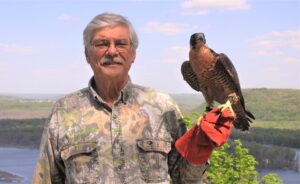
Our final flight was better than I had dared hope. Instead of merely flying away, Aurora hung around as if wondering what we were going to do next. The show quickly improved. Under the influence of the steadily warming cliff face, air currents were becoming lively. Like a kid playing on a department store escalator, Aurora descended toward the river and then caught a thermal that quickly shot her back overhead. After repeating the same act for a third time, she disappeared to the south but then returned a couple of minutes later.
I had not brought a long camera lens but, suddenly remembering my cell phone, I attempted a photo while Aurora played in the breeze hundreds of feet above the river. When she finally disappeared to the north, we did not see Aurora again. Although cheesy, the grainy phone photo provided a final memento of a boyhood dream come true.
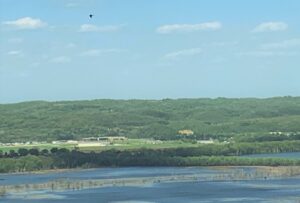
By now, you might be wondering why I would choose to permanently separate from a falcon that I claim to love and had waited six decades to obtain. The simplest explanation I can offer is this. In a completely wild setting, up to 70 percent of the peregrine falcons hatched in the arctic will not live to successfully complete their first 9,000-mile round trip migration to South America and back. But for those who do survive their first year, the chances for future survival skyrockets.
As a falconry bird, Aurora had no trouble surviving her first critical year. When failing to make a kill, she was still rewarded with ample amounts of food, something that never happens in the wild.
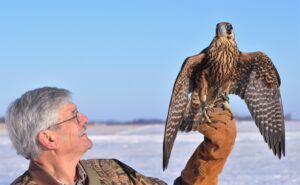
Female peregrines are capable of nesting during their third year. Currently entering her fourth summer, and in excellent condition, Aurora is a prime candidate for being lured to and establishing a nest site within the guarded territory of an adult male.
But here’s the clincher. The old school concept of allowing a falcon borrowed from the wild to return to the wild and complete its life’s cycle is an alluring prospect. The more I thought about liberating Aurora, the more compelling the notion became. In the end, it became my only choice. Although I have enjoyed training other [captive produced] peregrines, Aurora was unique. She was my first completely wild, free-flying peregrine; a bird that 1960s experts said I’d never see, let alone possess. For me, there will never ever be another bird like her. I will forever cherish the memory of our days afield. Wherever her continued journey may lead, I wish Aurora well.

 Tom Cope
Tom Cope Sue Wilkinson
Sue Wilkinson Susan Judkins Josten
Susan Judkins Josten Rudi Roeslein
Rudi Roeslein Elyssa McFarland
Elyssa McFarland Mark Langgin
Mark Langgin Adam Janke
Adam Janke Joe Henry
Joe Henry Kristin Ashenbrenner
Kristin Ashenbrenner Joe Wilkinson
Joe Wilkinson Dr. Tammy Mildenstein
Dr. Tammy Mildenstein Sean McMahon
Sean McMahon